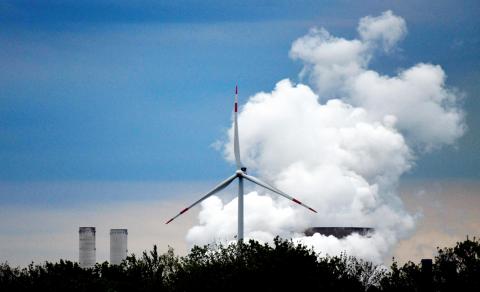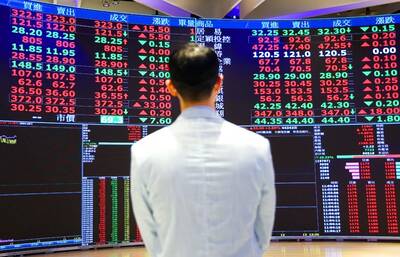Despite their surging popularity in Germany and elsewhere in Europe, the Greens did badly in Sunday last week’s election in the German state of Thuringia, and the nationalists from the Alternative for Germany (AfD) party did very well. An important reason is that the Greens support wind energy and the AfD militates against wind turbines. The giant windmills have grown so unpopular in neighboring communities that their construction in Germany has all but ground to a halt.
There are nearly 30,000 wind turbines in Germany, more than anywhere else in Europe. Only China and the US, both much bigger countries, have more.
Germany gets 23.5 percent of its energy from wind this year; it is the biggest source of renewable energy for the country.

Photo: AFP
However, in the first half of this year, only 35 wind turbines were added — an 82 percent drop compared with the first six months of last year.
Last year was bad, too: Just 743 turbines were added, compared with 1,792 in 2017.
This is happening because it is getting harder to get permission to erect the turbine towers. Local regulations are getting stricter.
Bavaria in 2014 decided that the distance between a wind turbine and the nearest housing must be 10 times the height of the mast, which, given the density of dwellings, makes it hard to find a spot anywhere. Wind energy development is practically stalled in the state now.
Brandenburg, the state surrounding Berlin, this year passed a law demanding that wind-farm operators pay 10,000 euros (US$11,100) per turbine each year to communities within 3km of the windmills.
Wind projects are also often rejected or stalled because they are deemed to interfere with military communications, air traffic control or broadcast radio stations.
Besides, local opponents of the wind farms often go to court to stall new developments or even have existing towers dismantled.
According to the wind-industry lobby BWE, 325 turbine installations with a total capacity of more than 1 gigawatt (about 2 percent of the country’s total installed capacity) are tied up in litigation.
The irony is that the litigants are often just as “green” as the wind-energy proponents — one is the large conservation organization NABU, which has said it is not against wind energy as such, but merely demands that installations are planned with preserving nature in mind. Almost half of the complaints are meant to protect various bird and bat species; others claim the turbines make too much noise or emit too much low-frequency infrasound.
Regardless of the validity of such claims, projects get tied up in the courts even after jumping through the many hoops necessary to get a permit.
Another reason for local resistance to the wind farms is a form of NIMBYism (“not in my backyard”): People hate the way the wind towers change landscapes. There is even a German word for it, Verspargelung, roughly translated as “pollution with giant asparagus sticks.”
In Thuringia, locals were appalled by a plan of the outgoing state government, which includes the Greens, to carve two areas for the turbines from a beloved forest.
There are 40 citizens’ groups working against more windmills in the small state of 2 million people, and they appear to be getting results: Only six towers have been erected so far this year, compared with 51 in 2017.
Even though most of the initiatives are environmentally motivated and the advocates want nothing to do with the AfD, ordinary voters who want to see fewer windmills built go with the party that promises to stop the projects.
This nasty political and regulatory climate creates too much uncertainty for investors, just as the German government prepares to phase out wind-energy subsidies. That ?vicious circle will ensue, understandably, worries the renewables industry.
A recent study carried out for the engineering lobby group VDMA predicted that, if the current obstacles persist, employment in the onshore wind industry, which stands at 64,200 people today, would drop by 27 percent by 2030.
Meanwhile, the German government, aware of the difficulties with wind development, has been trying to shift the emphasis in its ambitious new energy plans to solar.
However, it is hard to say whether building up photovoltaic energy production, which accounts for about 10 percent of the German energy mix today, can make up for the lagging wind development. Germany, after all, is not one of the world’s sunnier countries.
Without technological breakthroughs — for example, in energy storage, which would make fewer new turbines necessary — Germany, and then other countries that try to build up renewable energy generation as it has done, would be hard put to push production to the level required to reach climate goals.
In renewable energy, competition from fossil fuels is not the only problem: Local politics might be an even higher hurdle.
Leonid Bershidsky is Bloomberg Opinion’s Europe columnist. He was the founding editor of the Russian business daily Vedomosti and founded the opinion Web site Slon.ru.
This column does not necessarily reflect the opinion of the editorial board or Bloomberg LP and its owners.

IN THE AIR: While most companies said they were committed to North American operations, some added that production and costs would depend on the outcome of a US trade probe Leading local contract electronics makers Wistron Corp (緯創), Quanta Computer Inc (廣達), Inventec Corp (英業達) and Compal Electronics Inc (仁寶) are to maintain their North American expansion plans, despite Washington’s 20 percent tariff on Taiwanese goods. Wistron said it has long maintained a presence in the US, while distributing production across Taiwan, North America, Southeast Asia and Europe. The company is in talks with customers to align capacity with their site preferences, a company official told the Taipei Times by telephone on Friday. The company is still in talks with clients over who would bear the tariff costs, with the outcome pending further

A proposed 100 percent tariff on chip imports announced by US President Donald Trump could shift more of Taiwan’s semiconductor production overseas, a Taiwan Institute of Economic Research (TIER) researcher said yesterday. Trump’s tariff policy will accelerate the global semiconductor industry’s pace to establish roots in the US, leading to higher supply chain costs and ultimately raising prices of consumer electronics and creating uncertainty for future market demand, Arisa Liu (劉佩真) at the institute’s Taiwan Industry Economics Database said in a telephone interview. Trump’s move signals his intention to "restore the glory of the US semiconductor industry," Liu noted, saying that

NEGOTIATIONS: Semiconductors play an outsized role in Taiwan’s industrial and economic development and are a major driver of the Taiwan-US trade imbalance With US President Donald Trump threatening to impose tariffs on semiconductors, Taiwan is expected to face a significant challenge, as information and communications technology (ICT) products account for more than 70 percent of its exports to the US, Chung-Hua Institution for Economic Research (CIER, 中華經濟研究院) president Lien Hsien-ming (連賢明) said on Friday. Compared with other countries, semiconductors play a disproportionately large role in Taiwan’s industrial and economic development, Lien said. As the sixth-largest contributor to the US trade deficit, Taiwan recorded a US$73.9 billion trade surplus with the US last year — up from US$47.8 billion in 2023 — driven by strong

STILL UNCLEAR: Several aspects of the policy still need to be clarified, such as whether the exemptions would expand to related products, PwC Taiwan warned The TAIEX surged yesterday, led by gains in Taiwan Semiconductor Manufacturing Co (TSMC, 台積電), after US President Donald Trump announced a sweeping 100 percent tariff on imported semiconductors — while exempting companies operating or building plants in the US, which includes TSMC. The benchmark index jumped 556.41 points, or 2.37 percent, to close at 24,003.77, breaching the 24,000-point level and hitting its highest close this year, Taiwan Stock Exchange (TWSE) data showed. TSMC rose NT$55, or 4.89 percent, to close at a record NT$1,180, as the company is already investing heavily in a multibillion-dollar plant in Arizona that led investors to assume